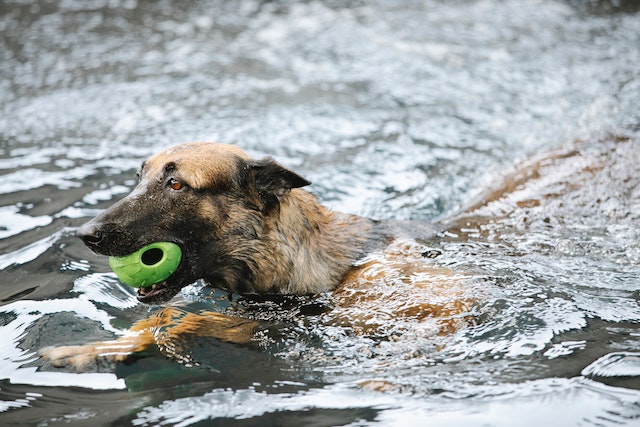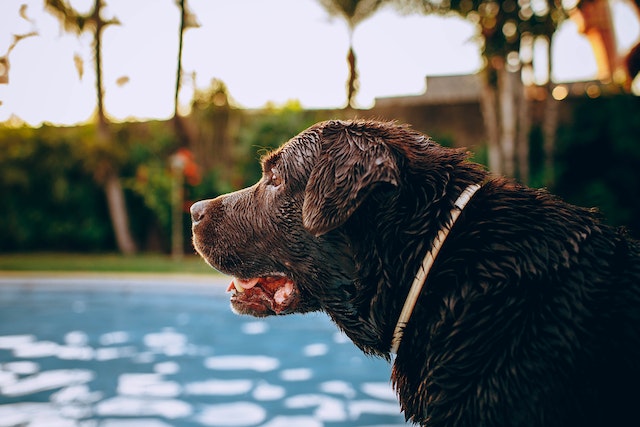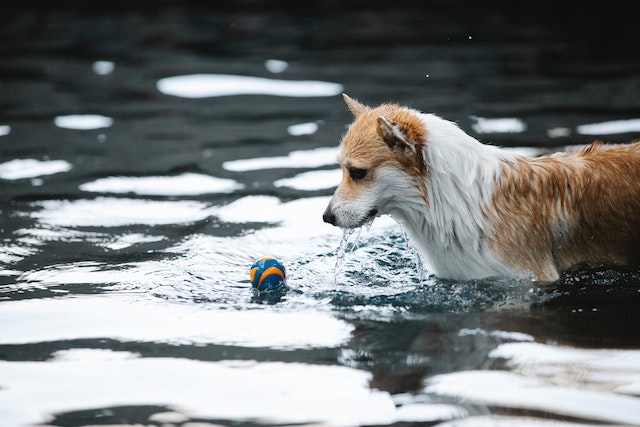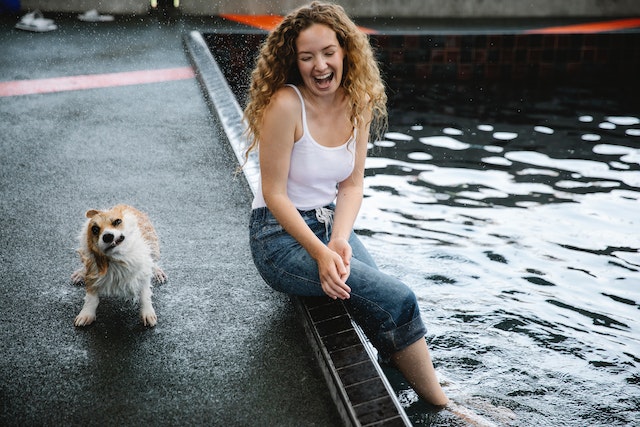
This article is contributed by guest author Sophia Foster (Writer at Designs By PoolAid).
Is It Safe for Dogs to Swim in Pools? Safe Swimming Tips for Pet Owners
For many, pets are more than just companions, they are family. As such, you want to ensure that they are safe and comfortable, especially when it comes to pool safety.
Keeping pets safe is one of the common lawn problems of any homeowner. If you want to learn how to keep your pet safe when you have a pool in your yard, or even indoors, read on.
As a homeowner with a swimming pool, ensuring the safety of your family and guests is a top priority. However, your responsibility doesn’t end with humans; it extends to your furry family members as well. Pet owners must be aware of the potential dangers their swimming pool presents to their pets and take the necessary precautions to ensure their safety

How to protect your dog from dangerous pool situations
When coming up with pool plan designs, it’s essential to consider the safety of your pets. A well-thought-out pool plan should include features that minimize the risk of accidents and ensure your pets can enjoy the pool area safely. Here are some tips to help protect your dog from dangerous pool situations:
- Install a pool fence
A pool fence is a must-have for any pet owner. This barrier can prevent your dog from accidentally falling into the pool when unsupervised. Choose a fence that is at least 4 feet high and has self-closing, self-latching gates to ensure maximum security.
- Provide proper supervision
Just as you would with a child, never leave your dog unsupervised around the pool. Accidents can happen in an instant, so it’s crucial to always keep an eye on your pet when they are near the water.
- Teach your dog to swim
While some breeds are natural swimmers, others may struggle in the water. Invest in swimming lessons for your dog or teach them yourself. This way, they will be better prepared to handle themselves in the water should they accidentally fall in.
- Create an easy exit
If your dog does end up in the pool, it’s essential to ensure they have a safe and easy way to get out. Install pool steps or a ramp designed specifically for pets to facilitate their exit from the water.

Chlorinated Pools: How to prevent your dog’s skin from being irritated
Chemicals used in swimming pools can irritate your dog’s skin, causing itching, redness, and discomfort. To prevent these issues, consider the following tips:
- Rinse your dog after swimming
After your dog has enjoyed swimming, rinse their coat thoroughly with fresh water to remove any residual chemicals.
- Use pet-friendly pool chemicals
Opt for pool chemicals that are less harsh on your dog’s skin. Consult with your pool maintenance provider or pet store for recommendations on pet-friendly products.
- Consult with landscaping services
Professional landscaping services can help you create a pool environment that is both beautiful and safe for your pets. By installing artificial grass around pool areas, you can reduce the amount of dirt and debris that enters the pool, subsequently lowering the need for harsh chemicals to keep the water clean.
- Regular grooming
Regular grooming can help to keep your dog’s coat and skin healthy. It can also help to remove any chemicals that may have been left on their coat after swimming.

How to prevent accidental drownings
Accidental drownings are a leading cause of death for pets, but they can be prevented with proper precautions and safe pool designs. Here are some ways to minimize the risk of accidental drownings in your pool:
- Invest in a pool alarm
A pool alarm is an excellent investment for pet owners. These devices can detect when something enters the water and alert you, allowing you to take action immediately.
- Use a pet life jacket
When your dog is swimming or playing near the pool, consider having them wear a pet life jacket. These floatation devices provide extra buoyancy, making it easier for your dog to stay afloat and reducing the risk of drowning.
- Train your dog to avoid the pool area
Establish boundaries and train your dog to stay away from the pool when they are unsupervised. Consistent training and positive reinforcement can help teach your dog to respect these boundaries, ultimately reducing the risk of accidental drownings.
- Regularly check pool covers
If you use a pool cover, ensure that it is securely fastened and free of damage. A damaged or improperly secured cover can pose a danger to your pets, as they may become trapped beneath it if they accidentally venture onto the pool’s surface.
- Maintain pool water levels
A few sips from a well-kept saltwater pool are not dangerous to pets. Keeping your pool’s water level consistent is essential to prevent your dog from struggling to exit the water. A low water level can make it difficult for your pet to reach the steps or ramp, increasing the risk of drowning.
How to prevent water poisoning
Water poisoning is one of the common lawn problems you could face when you have pets. It occurs when your pet ingests excessive amounts of water, leading to a dangerous condition called hyponatremia. This can happen when they play in the pool and accidentally swallow water.
To prevent water poisoning, consider these tips:
- Monitor your dog’s playtime
Keep an eye on your pet while they are playing in the pool and limit their time in the water to prevent excessive water intake.
- Create pet-friendly pool plans
Design your pool with your pet’s safety in mind by installing features like shallow areas or play zones to reduce the risk of accidental water ingestion.
- Encourage breaks
Encourage your pet to take breaks from swimming or playing in the water to reduce the chance of water poisoning.

Can my dog drink pool water?
While pool water is generally not toxic to pets, it’s essential to know that it’s not the best source of drinking water for your dog. The chemicals used to maintain the pool can upset your dog’s stomach, leading to digestive issues. Additionally, the pool water may contain bacteria or other contaminants that could be harmful to your pet’s health. It’s crucial to provide your dog with a separate source of clean, fresh water for drinking, and discourage them from drinking pool water.
How to prevent bacterial infection
When your pet comes into contact with contaminated pool water, they can contract the bacterial infection. Ensuring your pool’s cleanliness and working with professional landscaping services can help prevent these infections. Here are some ways to maintain a clean and safe pool environment for your pets:
- Keep your pool clean
Regularly clean your pool by removing debris and maintaining proper chemical levels. This will help minimize the growth of harmful bacteria in the water.
- Install artificial grass around pool areas
Installing artificial grass around pool areas can significantly reduce the amount of dirt, debris, and bacteria that enter the pool. Consult with landscaping services to determine the best options for your pool area.
- Provide regular grooming
Regular grooming can help to keep your pet’s coat clean and free of bacteria that may be present in the pool water. Make sure to rinse your pet thoroughly after swimming to remove any residual chemicals or bacteria from their coat.
- Maintain proper pool filtration
Ensuring your pool’s filtration system is functioning correctly will help to keep the water clean and bacteria-free. Regularly check and clean the filter to maintain optimal performance.
Conclusion
By incorporating these safety measures into your pool plans and enlisting the help of professional landscaping services, you can create a safe and enjoyable pool environment for both you and your pets.
